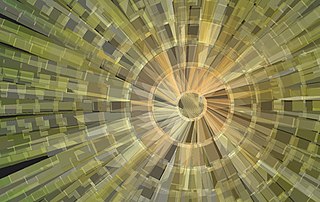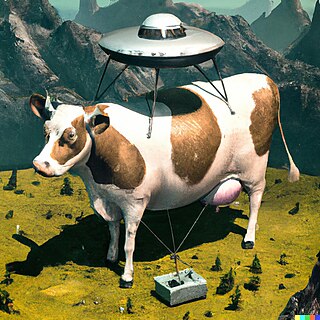Related Research Articles

Digital art refers to any artistic work or practice that uses digital technology as part of the creative or presentation process. It can also refer to computational art that uses and engages with digital media.

A chatbot is a software application or web interface that is designed to mimic human conversation through text or voice interactions. Modern chatbots are typically online and use generative artificial intelligence systems that are capable of maintaining a conversation with a user in natural language and simulating the way a human would behave as a conversational partner. Such chatbots often use deep learning and natural language processing, but simpler chatbots have existed for decades.
Interactive storytelling is a form of digital entertainment in which the storyline is not predetermined. The author creates the setting, characters, and situation which the narrative must address, but the user experiences a unique story based on their interactions with the story world. The architecture of an interactive storytelling program includes a drama manager, user model, and agent model to control, respectively, aspects of narrative production, player uniqueness, and character knowledge and behavior. Together, these systems generate characters that act "human," alter the world in real-time reactions to the player, and ensure that new narrative events unfold comprehensibly.
Dendral was a project in artificial intelligence (AI) of the 1960s, and the computer software expert system that it produced. Its primary aim was to study hypothesis formation and discovery in science. For that, a specific task in science was chosen: help organic chemists in identifying unknown organic molecules, by analyzing their mass spectra and using knowledge of chemistry. It was done at Stanford University by Edward Feigenbaum, Bruce G. Buchanan, Joshua Lederberg, and Carl Djerassi, along with a team of highly creative research associates and students. It began in 1965 and spans approximately half the history of AI research.

In computing, procedural generation is a method of creating data algorithmically as opposed to manually, typically through a combination of human-generated content and algorithms coupled with computer-generated randomness and processing power. In computer graphics, it is commonly used to create textures and 3D models. In video games, it is used to automatically create large amounts of content in a game. Depending on the implementation, advantages of procedural generation can include smaller file sizes, larger amounts of content, and randomness for less predictable gameplay. Procedural generation is a branch of media synthesis.

Algorithmic art or algorithm art is art, mostly visual art, in which the design is generated by an algorithm. Algorithmic artists are sometimes called algorists.
Evolutionary music is the audio counterpart to evolutionary art, whereby algorithmic music is created using an evolutionary algorithm. The process begins with a population of individuals which by some means or other produce audio, which is either initialized randomly or based on human-generated music. Then through the repeated application of computational steps analogous to biological selection, recombination and mutation the aim is for the produced audio to become more musical. Evolutionary sound synthesis is a related technique for generating sounds or synthesizer instruments. Evolutionary music is typically generated using an interactive evolutionary algorithm where the fitness function is the user or audience, as it is difficult to capture the aesthetic qualities of music computationally. However, research into automated measures of musical quality is also active. Evolutionary computation techniques have also been applied to harmonization and accompaniment tasks. The most commonly used evolutionary computation techniques are genetic algorithms and genetic programming.

Computational creativity is a multidisciplinary endeavour that is located at the intersection of the fields of artificial intelligence, cognitive psychology, philosophy, and the arts.
Pop music automation is a field of study among musicians and computer scientists with a goal of producing successful pop music algorithmically. It is often based on the premise that pop music is especially formulaic, unchanging, and easy to compose. The idea of automating pop music composition is related to many ideas in algorithmic music, Artificial Intelligence (AI) and computational creativity.
Artificial intelligence and music (AIM) is a common subject in the International Computer Music Conference, the Computing Society Conference and the International Joint Conference on Artificial Intelligence. The first International Computer Music Conference (ICMC) was held in 1974 at Michigan State University. Current research includes the application of AI in music composition, performance, theory and digital sound processing.

Artificial intelligence art is any visual artwork created through the use of artificial intelligence (AI) programs such as text-to-image models.
Synthetic media is a catch-all term for the artificial production, manipulation, and modification of data and media by automated means, especially through the use of artificial intelligence algorithms, such as for the purpose of misleading people or changing an original meaning. Synthetic media as a field has grown rapidly since the creation of generative adversarial networks, primarily through the rise of deepfakes as well as music synthesis, text generation, human image synthesis, speech synthesis, and more. Though experts use the term "synthetic media," individual methods such as deepfakes and text synthesis are sometimes not referred to as such by the media but instead by their respective terminology Significant attention arose towards the field of synthetic media starting in 2017 when Motherboard reported on the emergence of AI altered pornographic videos to insert the faces of famous actresses. Potential hazards of synthetic media include the spread of misinformation, further loss of trust in institutions such as media and government, the mass automation of creative and journalistic jobs and a retreat into AI-generated fantasy worlds. Synthetic media is an applied form of artificial imagination.

AI Dungeon is a single-player/multiplayer text adventure game which uses artificial intelligence (AI) to generate content and allows players to create and share adventures and custom prompts. The game's first version was made available in May 2019, and its second version was released on Google Colaboratory in December 2019. It was later ported that same month to its current cross-platform web application. The AI model was then reformed in July 2020.
Generative Pre-trained Transformer 3 (GPT-3) is a large language model released by OpenAI in 2020. Like its predecessor, GPT-2, it is a decoder-only transformer model of deep neural network, which supersedes recurrence and convolution-based architectures with a technique known as "attention". This attention mechanism allows the model to selectively focus on segments of input text it predicts to be most relevant. It uses a 2048-tokens-long context, float16 (16-bit) precision, and a hitherto-unprecedented 175 billion parameters, requiring 350GB of storage space as each parameter takes 2 bytes of space, and has demonstrated strong "zero-shot" and "few-shot" learning abilities on many tasks.

Generative Pre-trained Transformer 2 (GPT-2) is a large language model by OpenAI and the second in their foundational series of GPT models. GPT-2 was pre-trained a dataset of 8 million web pages. It was partially released in February 2019, followed by full release of the 1.5-billion-parameter model on November 5, 2019.

DALL·E, DALL·E 2, and DALL·E 3 are text-to-image models developed by OpenAI using deep learning methodologies to generate digital images from natural language descriptions, called "prompts."
Kenneth Owen Stanley is an artificial intelligence researcher, author, and former professor of computer science at the University of Central Florida known for creating the Neuroevolution of augmenting topologies (NEAT) algorithm. He coauthored Why Greatness Cannot Be Planned: The Myth of the Objective with Joel Lehman which argues for the existence of the "objective paradox", a paradox which states that "soon as you create an objective, you ruin your ability to reach it". While a professor at the University of Central Florida, he was the director of the Evolutionary Complexity Research Group (EPlex) which led the development of Galactic Arms Race. He also developed the HyperNEAT, CPPNs, and novelty search algorithms. He also co-founded Geometric Intelligence, an AI research firm, in 2015.

Midjourney is a generative artificial intelligence program and service created and hosted by the San Francisco–based independent research lab Midjourney, Inc. Midjourney generates images from natural language descriptions, called prompts, similar to OpenAI's DALL-E and Stability AI's Stable Diffusion. It is one of the technologies of the AI boom.

Generative artificial intelligence is artificial intelligence capable of generating text, images or other data using generative models, often in response to prompts. Generative AI models learn the patterns and structure of their input training data and then generate new data that has similar characteristics.
Generative literature is poetry or fiction that is automatically generated, often using computers. It is a genre of electronic literature, and also related to generative art.
References
- ↑ Cook, William Wallace (1928). Plotto. Battle Creek, MI: Ellis Publishing Company. p. 314.
- ↑ Eger, Markus, Colin M. Potts, Camille Barot, and R. Michael Young. 2015. “Plotter: Operationalizing the Master Book of All Plots.” In Eleventh Artificial Intelligence and Interactive Digital Entertainment Conference, 30–33. Association for the Advancement of Artificial Intelligence.
- ↑ Hogan, Robert J. (October 1935). "Inside an Author's Brain: The Birth of a Book Length Mystery Novelette". Writer's Digest .
- ↑ van Hise, James (2002). Pulp Masters. pp. 120–125.
- ↑ Bringsjord, Selmer; Ferrucci, David A. (2000). Artificial Intelligence and Literary Creativity: Inside the Mind of BRUTUS, a Storytelling Machine. Mahwah, New Jersey: Lawrence Erlbaum Associates. pp. 122, 150. ISBN 0-8058-1986-X.
- ↑ Meehan, James (1981). "TALE-SPIN" . In Schank, Roger C.; Riesbeck, Christopher K. (eds.). Inside Computer Understanding: Five Programs Plus Miniatures. New Haven, Connecticut: Lawrence Erlbaum Associates. p. 197. ISBN 0-89859-071-X.
- ↑ Pérez y Pérez, Rafael (2015). "From MEXICA to MEXICA-Impro: The Evolution of a Computer Model for Plot Generation". In Besold, Tarek Richard; Schorlemmer, Marco; Smaill, Alan (eds.). Computational Creativity Research: Towards Creative Machines. Atlantis Press. ISBN 978-94-6239-084-3.
- ↑ Lönneker, Birte; Meister, Jan Christoph; Gervás, Pablo; Peinado, Federico; Mateas, Michael (June 2005). Story Generators: Models and Approaches for the Generation of Literary Artefacts. Joint Conference of the Association for Computers and the Humanities/Association for Literary and Linguistic Computing. University of Victoria.
- ↑ Gervás, Pablo. "Story Generator Algorithms". The living book of narratology. Retrieved 12 October 2017.
- ↑ Vincent, James (14 February 2019). "OpenAI's new multitalented AI writes, translates, and slanders". The Verge. Retrieved 23 February 2021.
- ↑ Vincent, James (13 May 2019). "Use this cutting-edge AI text generator to write stories, poems, news articles, and more". The Verge. Retrieved 23 February 2021.
- ↑ "AI Storytelling Game May Expand Publishing's Horizons". www.publishersweekly.com. 28 August 2020. Retrieved 23 February 2021.